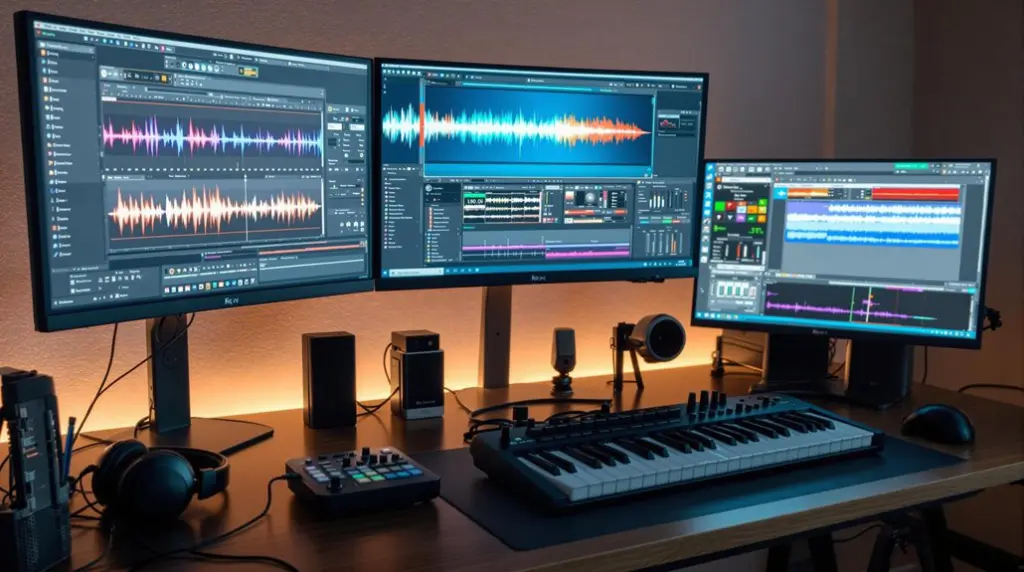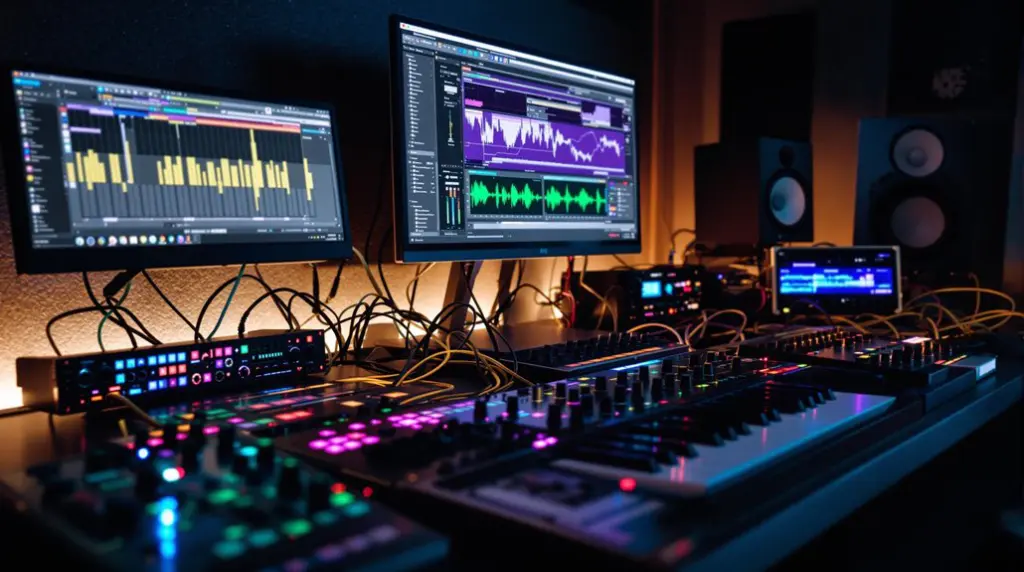Spectrasonics Omnisphere 2 VST stands out with its dual-layer architecture, enabling sophisticated sound design with a blend of synth and sample-based oscillators. Its modular user interface remarkably enhances workflow, featuring intuitive customization and advanced patch browsing with detailed descriptions and Sound Match functionality. The enriched effects engine, boasting 58 effect types, including 25 new additions and a unique Innerspace effect for convolution reverb, further boosts its sonic versatility. These elements collectively underscore Omnisphere 2’s unparalleled capabilities and pave the way for even deeper exploration into its extensive features.
Key Takeaways
- Dual-layer architecture allows simultaneous hosting of synth and sample-based oscillators for versatile sound creation.
- Over 14,000 sounds and 5,000 new sound sources enrich the sample library.
- Advanced layering techniques enable stacking of up to eight sounds for complex textures.
- Integration of 400 new DSP waveforms enhances sound design through wavetable synthesis.
- Enhanced effects engine includes 58 effect types, with convolution reverb for added depth and realism.
Sound Design and Synthesis
Delving into the sound design and synthesis capabilities of Spectrasonics Omnisphere 2, one encounters a remarkably versatile and powerful engine characterized by its dual-layer architecture. Each layer (A and B) can host either a synth or sample-based oscillator, facilitating intricate sound construction and manipulation.
The sound design potential is considerably enhanced by the expansion of the sample library, which now boasts over 14,000 sounds and 5,000 new sound sources, offering an extensive palette of textures. Additionally, the integration of analog and digital characteristics can be likened to the dynamic range compression techniques used to achieve clarity and consistency in audio.
Omnisphere 2’s advanced layering techniques enable users to stack up to eight sounds simultaneously via its stack mode. This functionality is ideal for creating complex, rich sonic textures suitable for a variety of musical genres.
The integration of over 400 new DSP waveforms through advanced wavetable synthesis further augments sound-shaping capabilities, allowing for innovative sound design.
Granular synthesis is another standout feature, providing granular manipulation capabilities that allow users to dissect and rearrange sound grains for uniquely refined outputs. This level of control opens up vast possibilities for sound designers, making Omnisphere 2 an indispensable tool for those seeking to push the boundaries of modern sound design.
User Interface Improvements
Building upon the robust sound design and synthesis capabilities, Omnisphere 2 also excels in providing a user-friendly, yet sophisticated, interface that greatly enhances the overall user experience. The interface design features a modular layout, which is both intuitive and visually appealing. This modularity allows users to easily access and adjust various features, streamlining the workflow for sound designers of all levels.
Emphasizing practical application, similar to the Production Music Live tutorials, Omnisphere 2’s design is tailored for both novice and experienced users.
A standout feature is the ability for workspace customization. Users can tailor their workspace to suit individual preferences, which considerably improves efficiency and comfort during extended sessions. The updated browser is another vital enhancement, offering detailed patch descriptions that enable users to quickly find and audition sounds based on specific criteria. This addition is complemented by the Sound Match functionality, which allows users to discover similar sounds effortlessly, thereby enhancing the sound exploration process.
Furthermore, Omnisphere 2 integrates seamlessly with MIDI controllers, providing hands-on control that is essential for both sound design and live performance. This MIDI integration fosters an engaging user experience, allowing for more dynamic interaction with the software.
Enhanced Effects and Browser
Omnisphere 2’s enhanced effects engine represents a considerable advancement in its sound design arsenal, introducing a staggering 58 effect types, 25 of which are entirely new. This extensive suite of effects underscores Spectrasonics’ commitment to effects versatility, enabling users to craft highly intricate and immersive soundscapes.
Remarkably, the Innerspace effect stands out by simulating convolution reverb, blending resonances from diverse spaces, thereby offering unparalleled depth and realism in sound design. Additionally, custom tags for mood and style can be applied to each effect, enhancing the organization and retrieval of specific sounds.
Complementing the powerful effects engine is the revamped browser, designed to maximize browser efficiency. The innovative Sound Match function is a game-changer, allowing users to swiftly locate patches similar to the current selection, thereby enhancing exploratory sound design processes.
The progressive loading system is another critical enhancement, facilitating immediate sound playback upon selection, which considerably streamlines the workflow and reduces downtime during creative sessions.
Additionally, the simplified patch-sharing process fosters a collaborative environment, making it easier for users to share and discover new, creative sounds.
These advancements collectively position Omnisphere 2 as a versatile and efficient tool for professional sound designers, ensuring both creative flexibility and operational efficiency.
Frequently Asked Questions
What Are the Cons of the Omnisphere?
The cons of Omnisphere 2 include the lack of a standalone version, limitations in sample handling and looping functionality, absence of modeled analog envelopes, and restricted modulation options for imported samples, which impact the user interface and sound design flexibility.
What Is so Good About Omnisphere?
Omnisphere excels in sound design with its extensive 14,000+ sound library, advanced synthesis capabilities, and powerful arpeggiator. Its intuitive user interface, featuring Sound Match and Sound Lock, greatly enhances user experience, making complex sound exploration efficient and effective.
What VST Is Better Than Omnisphere?
Given the myriad of VST alternatives, Massive excels in wavetable synthesis, Serum offers unparalleled sound design flexibility, Absynth provides unique sound generation, Pigments integrates modular synthesis, and ElectraX caters to aggressive sound palettes.
Is Omnisphere Still Relevant?
Omnisphere remains highly relevant due to continuous Omnisphere updates and exceptional Omnisphere versatility. Its evolving sound design capabilities, integration with hardware synthesizers, and extensive library guarantee it meets the dynamic needs of contemporary music producers.
Conclusion
Spectrasonics Omnisphere 2 VST stands as a formidable tool in the domain of music production, owing to its robust sound design and synthesis capabilities, user interface improvements, and enhanced effects and browser functionalities. These features collectively enable an improved level of creativity, efficiency, and precision in sound production. The advancements in Omnisphere 2 not only streamline the workflow for producers but also offer an all-encompassing suite of tools that contribute greatly to the quality and versatility of musical compositions.




